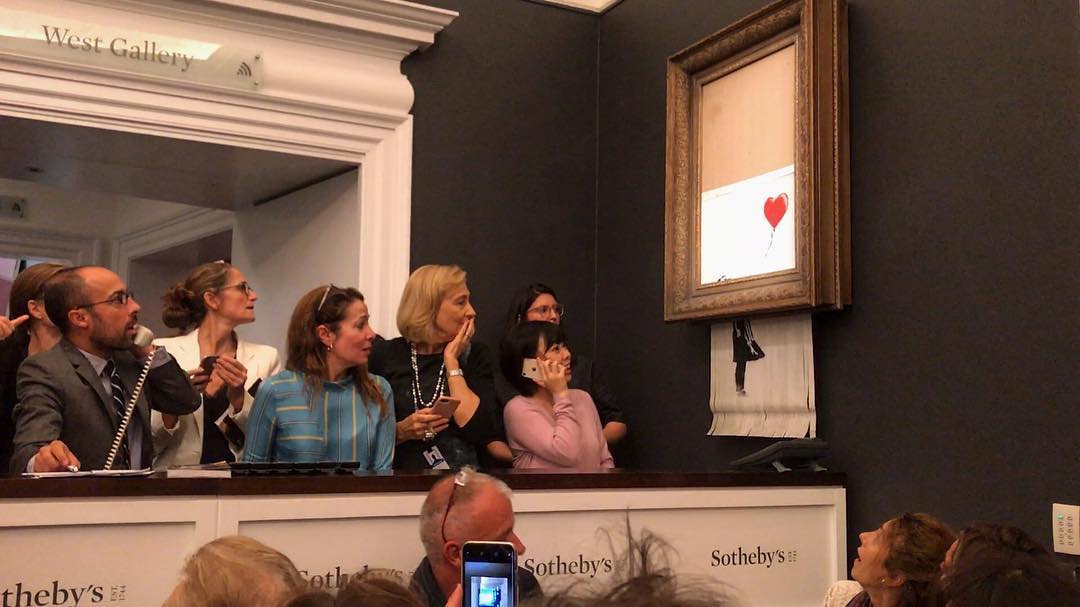 BANKSY AUCTION STUNT LEAVES ART WORLD IN SHREDS
BANKSY AUCTION STUNT LEAVES ART WORLD IN SHREDS
My class this morning, was discussing the aggressive and often violent ideas of the Futurists and others in the early part of the 20th century. I was still thinking about Tomasso Marinetti, Tristan Tzara, and other provocateurs when I read about Banksy’s newest performative gesture; simultaneously a real time spectacle about wealth, class, and the value of art, and also a very inside the art world, hermetic one-liner that implicates both the system as well as artists who pander to it.
At a recent Sotheby’s contemporary art auction in London, the bidding for Banksy’s Girl With Balloon had just finished and the painting had sold for $1.4 million.  Suddenly, an alarm sounded in the auction room and the canvas, which had been on display, then began sliding down inside its frame, auto-shredding itself, and emerging at the bottom of the frame in the familiar narrow strips we are familiar with as office paper runs through similar machines. In this case, it seems, Banksy’s work began shredding itself via a remote-control mechanism on the back of the frame. Apparently inspired by Picasso’s reference to painting as “a sum of destructions,” the provocation has other roots in early 20th century manifestos that elevate the agitation of the status quo to that of a theology. Indeed, much of Banksy’s work echoes the Futurist’s idea that, “that the spectator [must] live at the center of the painted action”, or in other words, at the vortex of the spectacle.
Suddenly, an alarm sounded in the auction room and the canvas, which had been on display, then began sliding down inside its frame, auto-shredding itself, and emerging at the bottom of the frame in the familiar narrow strips we are familiar with as office paper runs through similar machines. In this case, it seems, Banksy’s work began shredding itself via a remote-control mechanism on the back of the frame. Apparently inspired by Picasso’s reference to painting as “a sum of destructions,” the provocation has other roots in early 20th century manifestos that elevate the agitation of the status quo to that of a theology. Indeed, much of Banksy’s work echoes the Futurist’s idea that, “that the spectator [must] live at the center of the painted action”, or in other words, at the vortex of the spectacle.
At this moment in history, watching Banksy have his way with a bunch of wealthy art patrons seems disconnected and almost whimsical. While some parts of the art world are in a dither about Banksy’s latest spectacle/artwork/PR stunt (and I am a big fan of performance and other art practices that stand up for social justice) it seems to be increasingly the case that these spectacles occur in a vacuum. Banksy’s work, in its earliest incarnation, seemed to be about, value, expectations, class, privilege and other such utopian ideals. He was a joker, a jester, and a one-person movement, a mirror for our own desires reflecting whatever we believed about art or proving the dispositive; that it is all simply a hoax or a scam. Banksy seemed to me to be the co-mingled afterlife of Marcel Duchamp, Andy Warhol, and Keith Haring all jumble together; a provocateur for the 21st Century.
Within the fertile period at the start of the 20th century there were a myriad of movements that staked a claim as agent-provocateurs of there era. Futurism, Dada, and Surrealism are perhaps the three that get the most traction and that, in their own way became “brands” just as Google or Apple have become recognizable brands of this era. Decidedly, the artists of the Futurist, Dada, and Surrealist movements had agendas that differed from Apple or Google, but they were as fully formed as today’s tech companies.
We are arriving at a juncture in this story that is for me where the roots of contemporary art begin to take hold. One of the recognizable traits of art in our contemporary era is the idea of borderless practices. That is to say, that we see in contemporary art, a tendency in which previously discrete disciplines overlap and merge into new multi-disciplinary modes of expression. We see painters painting on things rather than painting image of things; we see sculptors using real live bodies to create spatial relationships and patterns in real time; we see dancers and choreographers collaborating with visual artists to create huge visual spectacles; we see visual artists turning to film to create expressions of rhythm, pattern and optical illusion. We see artists using visual means to illustrate psychological states and the dream-like unconscious. We see artists creating systems of language and sound scores that echo the cacophony of modern life. It is clear that the intermingling of disciplines has inexorably and forever altered the conditions and understanding of art. There is no returning to the parochial understanding of purity as a prerequisite for art nor is gender or class or even an education in art a condition of marginalization.
Banksy has branded himself in much the same way that the artists of Dada did, or for that matter, in the way that Apple or Google have. Without the cooperation of a public, the provocation has no resonance. One must care about a self-destructive artwork for the brand to have traction.
Douglas Rosenberg
Chair, UW-Madison Art Department
